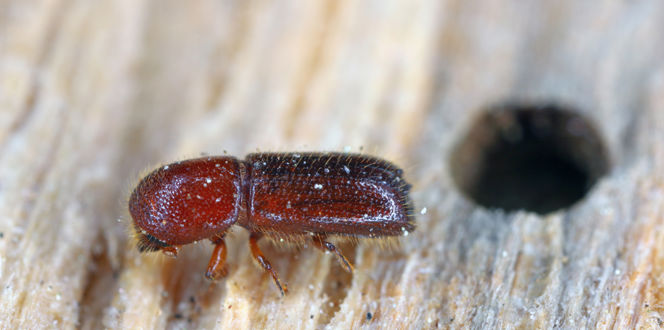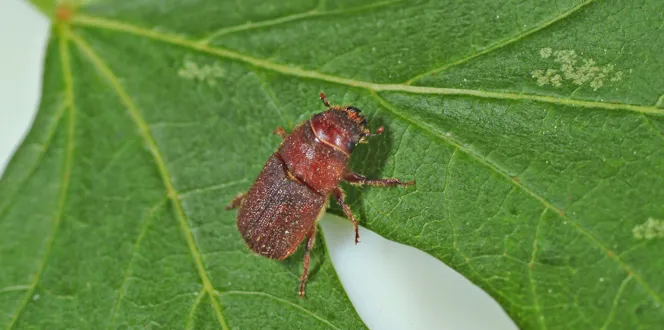The many species of borer insects around the world come in unique colors and sizes. But they all have one major thing in common—they can be seriously destructive to our trees.
Borers tunnel into trees to feed on their inner wood. Symptoms can be slightly different depending on the borer, but in general, these critters create holes in tree bark, leave behind sawdust or sap and cause leaf discoloration and branch dieback, and can ultimately kill the tree.
Below, learn how to identify tree borers and get info on treatment.
Common tree borers
The four wood boring insects mentioned below attack a wide range of trees. Usually, native borers (like the bronze birch borer) seek out trees that are already stressed, i.e., by drought, disease, or maybe a pruning injury.
But, healthy trees aren’t off the hook. Non-native borers like the emerald ash borer will chomp on trees no matter their health. That’s why it’s important to keep an eye out for tree borers on any and all trees that are susceptible.
Emerald Ash Borer
Trees at risk: The emerald ash borer (EAB) primarily feeds on ash trees.
Where you’ll find them: This pest has been found in over 25 states, including Alabama, Arkansas, Colorado, Connecticut, Delaware, Georgia, Illinois, Indiana, Iowa, Kansas, Kentucky, Maryland, Massachusetts, Michigan, Minnesota, Missouri, Nebraska, New Hampshire, New Jersey, New York, North Carolina, Ohio, Oklahoma, Pennsylvania, Tennessee, Texas, Virginia, West Virginia and Wisconsin. Find a full list of affected states here.
Common symptoms: EAB has several staple symptoms. In the early stages, you may see visible cracks on main branches in the canopy. As the infestation develops, you’ll find thin, 2-5-inch vertical slits in the bark and D-shaped holes in the bark and the canopy will begin to thin. Find a full list of symptoms here.
What to do next: Contact your local arborist as soon as you spot any symptoms. EAB treatment is most effective when you act early.
Locust Borer
Trees at risk: Black locust trees are vulnerable. Other species, including honey locust, are not at risk.
Where you’ll find them: Find the locust borer anywhere black locust trees are found. Black locusts are native to many eastern and southern states, including Alabama, Arkansas, Georgia, Kentucky, North Carolina, South Carolina, Tennessee, Virginia and West Virginia.
Common symptoms: A major indicator of a locust borer infestation is a swell on the trunk or a branch that looks like a knot. Other symptoms include several broken branches, thinness in the top part of the tree, exit holes in the bark, and sawdust at the base of the trunk.
What to do next: Have an arborist inspect your tree for hazards ASAP. The locust borer weakens branches to the point that they can break, so it’s important to make sure your tree is stable. From there, your arborist will help you determine if your black locust is a good candidate for treatment.
Bronze Birch Borer
Trees at risk: Paper birch, gray birch and yellow birch are commonly attacked when stressed, and Asian and European species of birch are susceptible even when healthy. River birch is not attacked by bronze birch borer.
Where you’ll find them: You can find bronze birch borer throughout the U.S. wherever white barked birches are grown, from Maine to Washington state and Georgia to California.
Common symptoms: Below the bark, this borer creates winding tunnels, which makes the outer layer of bark look wrinkled or bumpy. You may also notice D-shaped holes in the bark, discolored and sparse leaves in the top part of the tree and dead branches throughout the tree.
What to do next: Ask a professional arborist to inspect your birch tree. An insecticide treatment can help trees with minor damage if an infestation is spotted early.
Longhorned Beetles
Trees at risk: A variety of trees are susceptible to longhorned beetles, which generally colonize only trees that are severely stressed. To name a few, oak, linden, maple, poplar, willow, elm and ash make the list.
Where you’ll find them: Longhorned beetles are a family of several species of pests that are found around the world. An example is the invasive Asian longhorned beetle, which has destroyed trees in isolated populations in eastern states like Illinois, New Jersey, New York and Ohio that have been subject to eradication. Other species like the red oak, linden, and redheaded ash borers are native to the United States.
Common symptoms: Longhorned beetles have telltale symptoms including discolored leaves, sawdust at the base of the tree or on branches, and round holes throughout the tree’s trunk.
What to do next: Your best next step is to contact an arborist as soon as you spot symptoms. In the case of the Asian longhorned beetle, for example, slowing the spread of this pest is super important, so your arborist will want to take quick action. An arborist can also help with diagnosis and treatment if you’re not sure what type of pest you’re dealing with.





